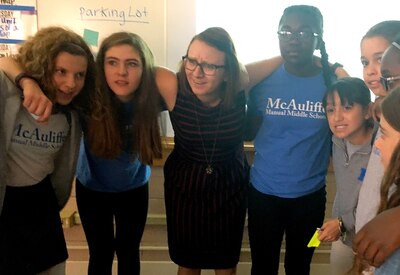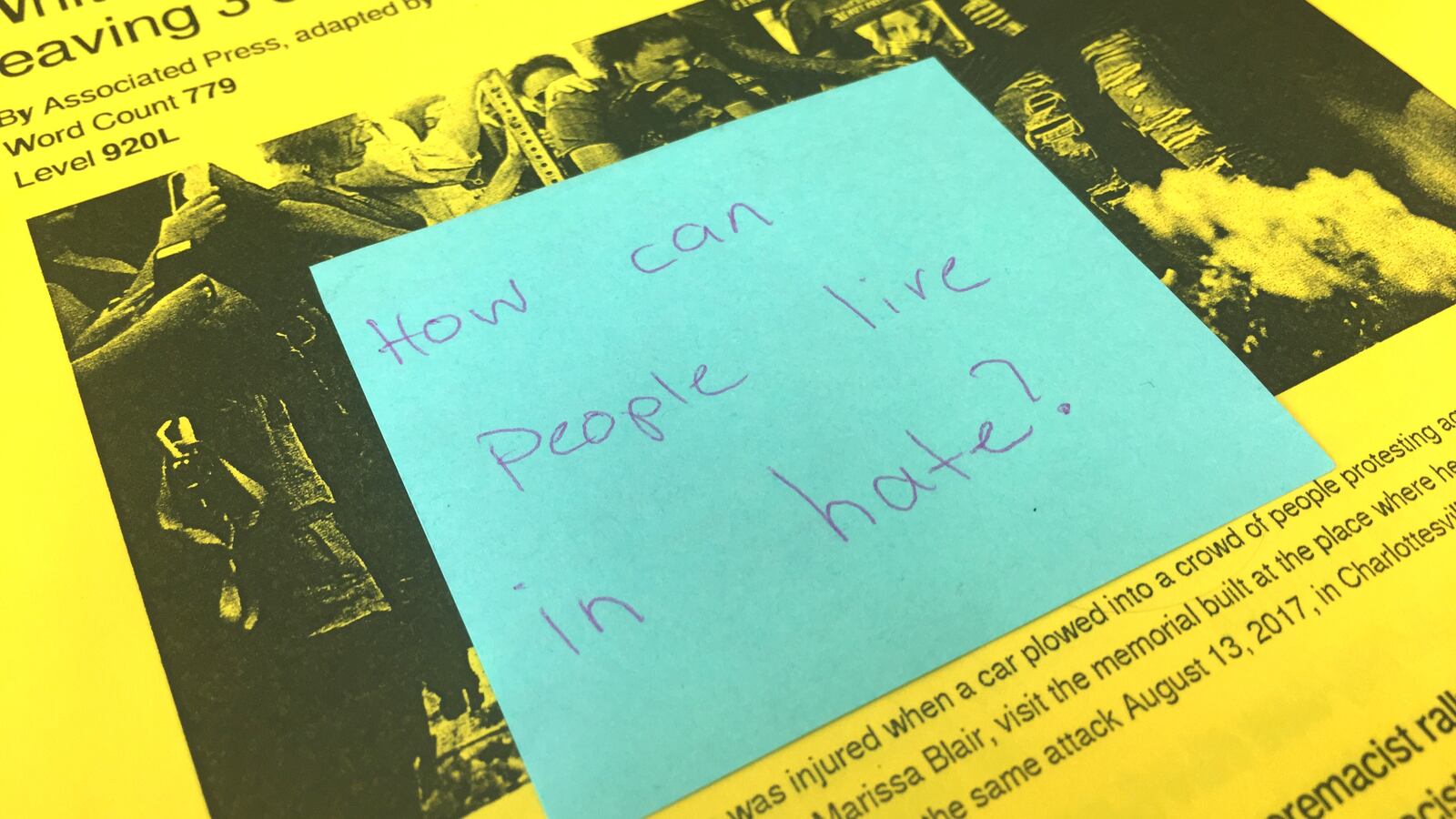On Thursday morning, 10 seventh-grade girls sat in a circle in a third-floor classroom decorated with world flags and quotes from Maya Angelou, Sitting Bull and Abraham Lincoln.
They were soft-spoken as they passed around a talking stick — delving tentatively into a topic that last weekend’s white supremacist rally in Charlottesville, Va., put in stark relief: racism in America.
The girls, students at Denver’s McAuliffe Manual Middle School, had already read copies of a news article about the events that left three dead — one counter-protester mowed down in the street and two state police pilots monitoring the rally who died in a helicopter crash.
Now, they jotted down questions on colorful sticky notes. There were straightforward ones such as, “How did the helicopter crash?”
There were also bigger, more complicated questions: “How can people live in hate?” and “What is our president doing to stop this?”

Mirroring conversations happening in classrooms nationwide, social studies teacher Sarah Frederick walked the class through a discussion not just about the events in Charlottesville, but the students’ own brushes with prejudice and their nascent ideas for tackling racism.
While some Colorado schools aren’t yet back in session and others are just getting started, many educators plan to follow suit in the coming weeks — incorporating Charlottesville into lessons on everything from history to media literacy to creative writing.
To help arm Denver-area educators with resources for covering the recent news along with a tangle of related issues, Hayley Breden, a social studies teacher at Denver’s South High School, is planning a meet-up Saturday morning at a public library in Arvada.
“It could be three people who show up. It could be 50,” she said. “I just wanted to provide teachers with a place to talk about what happened and I wanted them to feel confident in addressing these things with students.”
In Jeffco Public Schools, the state’s second largest school district, Superintendent Jason Glass released a statement on Charlottesville and asked for community feedback on it.
Glass, who is new to the role, included the statement in a letter sent to families Wednesday, writing that the district respects free speech but won’t tolerate threats or harassment.
Denver Public Schools Superintendent Tom Boasberg alluded to Charlottesville as he made the rounds of district schools that got an early start this week.
“We have an important role in giving supports and resources to teachers as they head back to class to directly address the events of the weekend, and the important reflection and learning we must do as a community in the face of such repugnant actions,” he told Chalkbeat.
Resources for teaching about Charlottesville are available from a number of sources, including Teach Plus, Facing History and Ourselves and the #CharlottesvilleCurriculum hashtag on Twitter.
Breden said it’s important to get beyond a simplistic “racism is bad” message and dig into bigger issues such as the distinction between free speech and hate speech, the impact of racism locally, and the many forms of racism beyond slurs and chants at a rally.
Manual High School history teacher William Anderson feels much the same way. He sees Charlottesville as a high-profile example of overt racism, but just the tip of the iceberg. He wants his 11th- and 12th-graders — most of whom are students of color — to understand how deeply embedded racism is in the fabric of American life.
“Why are we OK with talking about individual acts and we’re not so interested in talking about these things at a systemic level?” he asked.
He plans to do both once the school year starts on Monday — weaving Charlottesville, which he knows will be fresh in students’ minds, into broader themes he’d already planned on racism’s role in American history, the media landscape and even the college experience for students of color.
In Frederick’s class, where about half the students are black, half are white and one is Latina, she made sure the seventh-graders knew that Colorado had its own racist realities to confront.
“How many of you have heard of Stapleton?” she asked, referring to the northeast Denver neighborhood named for a former Denver mayor and Ku Klux Klan member.
The girls turned their attention to a black and white photo on the screen at the front of the room showing scores of hooded klansmen marching through the streets of Denver. The events in Charlottesville weren’t so far away.
The students were most vocal in recounting experiences where they or someone they knew had experienced racism.
One girl, whose mother is African-American and whose father is white, said her parents had been called names. Another said her African-American father had been stopped in customs for extra questioning while the rest of the family had sailed through.
One girl, who wore a sparkly crown in honor of her birthday, said she and her mom had been pulled aside by a store employee after buying party supplies.
“This white lady, she kept looking through the bags and kept looking at the receipt and then she pulled us over,” the girl said.
After the girls shared their experiences Frederick thanked them.
“I know that’s really heavy stuff,” she said. “But what I want you to understand is that that does not have to be the world we live in.”
The hardest part for Frederick’s students, who are just 11 and 12 years old, was figuring out what they could do about racism and hate.
As Frederick wrapped up the 40-minute discussion, promising it would continue on Monday, she asked, “What’s our responsibility? … What do we do now?”
Most of the students sat silently. A couple said they couldn’t do a lot, but offered tentative suggestions: Maybe they could share their thoughts on social media, attend local peace marches or communicate their views to more powerful people.
One girl had a different take.
“I think we could do something really big if we wanted to and if we tried really hard,” she said. “I don’t think there’s really a limit for us if we put our mind to it.”
Chalkbeat reporter Melanie Asmar contributed information to this report

